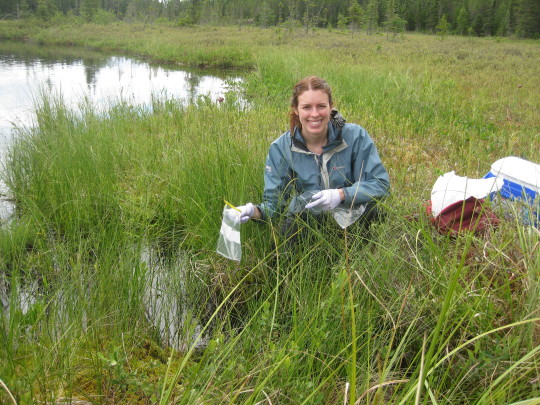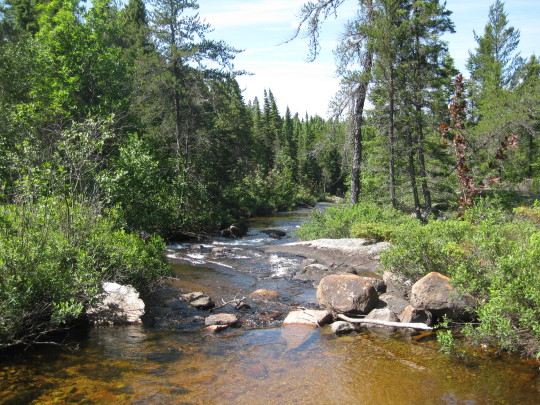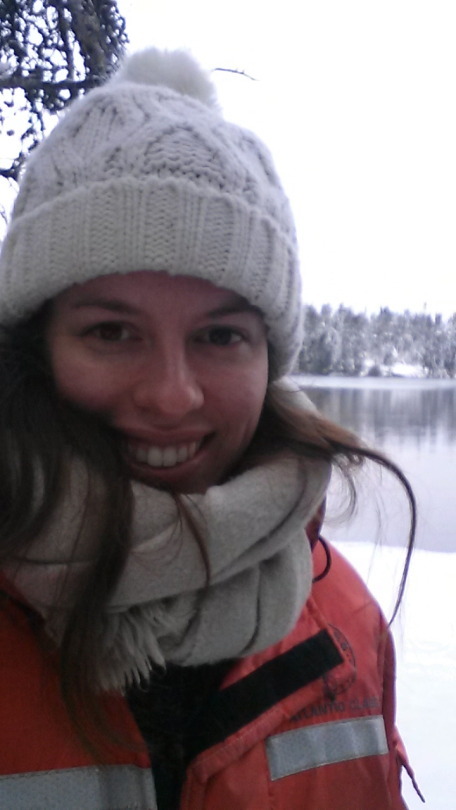Holding my cooler of precious samples close to my chest, the mat of vegetation suddenly gave way beneath me and I slipped into the bog, coating my entire thigh in stinky swamp goo. But the precious water samples nestling inside the cooler were safe. Phew. My field assistants helped me back into our boat. One more lake checked off a long list. I was spending my summer investigating how traces of environmental DNA can help with species detection. You can think of this work as “forensic ecology” – using tiny traces of DNA in water or soil samples to detect the presence of species. I collect water samples in the field, filter them, and then extract the DNA for next-generation sequencing. I investigate how environmental DNA behaves in connected habitats, as well as different habitat types (hence the swamp goo!).

Sampling water for DNA can tell us which aquatic animals live there.
My work is conducted at the IISD-ELA (Experimental Lakes Area), one of the world’s most influential freshwater facilities. Opened in 1968, the site is effectively a living laboratory where classic studies on eutrophication and acidification have taken place on the whole-ecosystem scale, thanks to 58 lakes set aside for scientific research. The advantages for me? They have one of the longest continuously monitored freshwater datasets in the world, meaning that I could validate environmental DNA results against population data.
So that’s how I ended up struggling through the swamp. As I’m interested in how environmental DNA flows around the landscape, my experimental design included visiting some very remote sites in my fieldwork. A couple of my lakes had not been visited by any scientist at the field station. It was very special to think that I was visiting a lake that no one had set eyes on for years, but the challenges of working with environmental DNA in hard-to-access sites were very real. Because I rely on traces of DNA, their concentration is much lower compared with DNA in tissue or muscle. Samples were double-bagged inside the cooler, with glove changes between each sample collection. Each individual piece of equipment was carefully cleaned and sealed away the previous evening, to protect them from the rigors of the field.

The flow of water could transport environmental DNA from upstream, possibly influencing our estimates of species detection.
Back in the lab, issues around contamination were no different. Even being in the same room as tissue samples could cause contamination of these sensitive environmental samples. IISD-ELA was celebrating one of its busiest years yet, and it was no small request to find a space that wasn’t occupied by enthusiastic scientists working with fish and zooplankton. I was found a small disused room, which with a little adjustment, made the ideal location for filtering water. Dry ice and some helpful collaborators were instrumental in transporting the filters back to McGill for DNA extraction, although I confess that I didn’t sleep much until they were safely stored in the freezer back home after their epic journey.
This winter at McGill, I will be spending my time performing the molecular work to turn the simple filter papers into millions of DNA sequences (hopefully). This project has been really satisfying, as the study design is entirely my own, and although the fieldwork was difficult, we eventually succeeded in collecting every sample I needed (something that isn’t always possible in the field). I can’t wait to see the results!

Joanne Littlefair is a Mitacs postdoctoral fellow working metabarcoding techniques and eukaryotic environmental DNA. Her project is a collaborative partnership between the Cristescu lab at McGill and WSP Montreal, a building and environmental consultancy. She is developing metabarcoding techniques to monitor freshwater fish populations. Joanne is also interested in applying molecular techniques to analyse diet, gut contents and track trophic interactions.

0 Comments